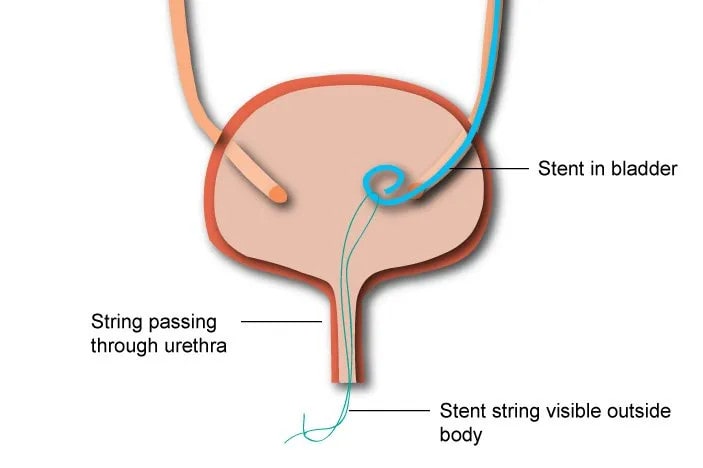Kidney Stone and Urinary Stone Treatment
What are Kidney and Urinary Stones?
The kidneys are two bean-shaped organs that help in the removal of wastes from the body. As the kidneys filter blood of impurities, minerals and acid salts can accumulate and harden over time. These solid crystalline deposits are called kidney stones, and can form in one or both kidneys.
The kidney and urinary stones can travel down the urinary tract and block the flow of urine, causing pain and bleeding. Kidney stone formation is a common urinary system disorder that can form in any individual. However, men and overweight people are at a higher risk of developing them.
Causes of Kidney Stones
Kidney stones and urinary stones form when certain salts and minerals in the urine build up and become highly concentrated. This can happen due to
- Insufficient water intake
- Treatments for kidney diseases and cancer
- Certain medications
- Family history
- Intestinal disease such as Crohn’s disease
- Single functional kidney
Symptoms of Kidney Stones
Symptoms of kidney stone formation may not manifest until the stone moves down into a narrow drainge tube, called the ureter (connecting the kidney to the bladder). Symptoms may include:
- Severe pain below the ribs, back, sides, lower abdomen, groin and during urination
- Pain that fluctuates in intensity
- Frequent urge to urinate
- Blood stained (Pink, brown or red) urine
- Superimposed infection – UROLOGICAL EMERGENCY
You should seek immediate medical attention if you find it difficult to pass urine, or the pain is accompanied with fever, chills, nausea and vomiting.
Diagnosis of Kidney Stones
When kidney stones are suspected, Dr Kim may order blood, urine and imaging tests (X-ray, Ultrasound, CT scans) to diagnose the condition. You may also be asked to urinate through a sieve to collect and test the kidney stones that pass in the lab. The results will help him to determine the cause and formulate an appropriate plan for treatment.
Kidney Stones & Urinary Stones Treatment
A great majority of stones are small (less than 4-5mm) and pass spontaneously.
Small kidney stones can be flushed out by drinking plenty of water every day or through medication. Additionally, Dr Kim and his team may prescribe medication to relieve pain. Further treatment depends on the type of stone and its underlying cause.
Surgical urinary and kidney stone treatment may be warranted in specific circumstances to treat those stones causing persistent symptoms, or if it results in potential kidney damage or infection. If surgery is deemed necessary, the vast majority can be treated with minimally invasive option allowing quicker recovery.
For larger urinary or kidney stones, Dr Kim may suggest certain procedures based on the location and size of the kidney stones.
Laser Therapy for Kidney Stones
What is Laser Stone Surgery?
Laser Stone Surgery is used to treat stones in the entire urinay tract right from the collecting system in the kidney, through the ureter to the bladder.
Rigid Ureteroscope is typically used for stones in the ureter (drainage tube connecting the kidney to the bladder) closer to the bladder. A thin lighted tube called an ureteroscope is inserted through your urinary tract opening. Once the stone is located, laser fibre is introduced for fragmentation and tiny forceps or a basket shaped instrument at the end of the scope grabs and removes the fragments.
Flexible Ureteropyeloscope (or Retrograde Intrarenal Surgery- RIRS), a long thin lighted telescope (2.5mm diameter) with a flexible tip is used for stones in the kidney or in the ureter towards the kidney. It is introduced from outside the patient into the stone without the need for any incision. The instrument allows visualisation of the entire kidney and the ureter due to the flexible nature of the scope. Holmium laser fibres (0.27mm in core diameter) are used to fragment stones and Micro-baskets to retrieve any stone fragments for analysis. Kidney stones up to 1.5cm in size can be treated using this approach.

Ureteroscopy and Laser Lithotripsy
Advantages of Laser Stone Surgery?
The benefits of Laser Stone Surgery are:
- Allows stone treatment without the need for any incision by using the urethral orifice as the entry point
- A highly successful technique (over 95%)
- Can be performed as day surgery
- Allows to obtain stone specimen to assess stone composition
Disadvantages and risks of Laser Stone Surgery?
This is generally considered a very safe operation. Specific risks to surgery include:
- More invasive compared to shock wave lithotripsy
- stent irritation (Flank/groin pain on urination, haematuria, frequency and urgency symptoms)
- infection,
- minor bleeding, and
- perforation of the ureter (1 in 200)
Before Laser Stone Surgery?
As the procedure is performed under general anaesthesia, you should have nothing to eat or drink for 6 hours prior to treatment.
Regular medications can be taken with a sip of water with the exception of heavy blood thinning agents (eg. warfarin, clopidogrel) or non-steroidal anti-inflammatories which may need to be stopped beforehand. Dr Kim and his team will advise you about your specific circumstances.
A midstream urine (MSU) test is required to ensure the urine is sterile before treatment is undertaken.
Day of Laser Stone Surgery
What do I need to bring to surgery?
- All related imaging such as x-rays, CT scan or ultrasound
- Your usual medications
During Laser Stone Surgery?
You will meet your anaesthetist prior to surgery who will take a thorough medical history and physical examination. This person will be responsible for your safety whilst you are under general anaesthesia.
The procedure will usually take 60 minutes and involves putting a telescope into the ureter or kidney and fragmenting the stone with a holmium laser.
A temporary double J ureteric stent may be left in place for a short period of time to ensure the kidney drains without risk of blockage.
After Laser Stone Surgery Care
It is normal to feel the need to pass urine frequently and notice blood in the urine following surgery. This will settle over the ensuing days.
You need to drink at least 8 glasses of water a day (2.5L/day). Simple analgesics such as Panadol and Nurofen are usually all that is required, occasionally stronger medication (eg. Panadeine Forte) may be necessary.
An oral over the counter medication called the Ural can reduce the stinging sensation during urination.
You may wake up with a temporary ureteric stent (see ureteric stent information sheet) following the surgery which allows any swelling in the ureter to settle from where the stone was sitting and causing irritation. Some patients will experience discomfort or irritation due to ureteric stent. These symptoms would include pain on urination, blood in urine or increased urinary frequency or urgency symptoms. Depending on the types and severity of your stent discomfort Dr Kim might suggest pain relief, alpha blockers, or bladder relaxant.
The stent may be attached to a string tether coming out from the urethra which allows easy removal in Dr Kim’s office. Care needs to be taken so as not to accidentally dislodge the stent by allowing it to get caught on your underwear.
A script for oral antibiotics will need to be taken for a few days to prevent infection.
You will be advised after surgery the necessary follow-up arrangements.
You will not be able to drive for at least 24 hours after surgery as you have had a general anaesthetic.

Stent on a string
Percutaneous Nephrolithotomy for Kidney Stones
Percutaneous Nephrolithotomy (PCNL) is the preferred technique for treating larger kidney stones located within the kidney.
The procedure involves keyhole surgery that is performed through a 1 cm incision in the skin.
The percutaneous nephrolithotomy (mini-PCNL) can be achieved through a sheath too small to accommodate a standard rigid nephroscope. While similar in approach, it represents a refinement in the technique due to having smaller cameras, better stone lasers and specialised tools. The incision that is made in the skin is much smaller and allows for quicker patient recovery and results in a safer procedure.
Extracorporeal Shockwave Therapy for Kidney Stones
Extracorporeal Shock Wave Lithotripsy (ESWL) is a form of non invasive surgical stone treatment using high frequency sound waves from an external source (outside the body) to break up kidney stones into smaller pieces, and allow them to pass out through the urinary tract.
The shock waves vibrate and break the stones down without harming the rest of the body. The stone fragments can then pass out in the urine over the next few days. It is performed as day surgery under general anaesthetics.
Sometimes, your surgeon may insert a stent or tube before or after the procedure through the bladder or the back into the kidney to hold the urinary tube open, preventing the pieces from blocking the tube.
Pyelolithotomy / Nephrolithotomy / Ureterotomy / Diverticulectomy for Kidney or Ureteric Stones
Very occasionally, a more invasive surgery might be required if the above options would not offer satisfactory outcomes.
This can be performed via open or laparoscopic or more recently, robot-assisted minimally invasive approach.
Should you need urinary stone and kidney stone treatment in Sydney, fill out the contact form now to enquire!
